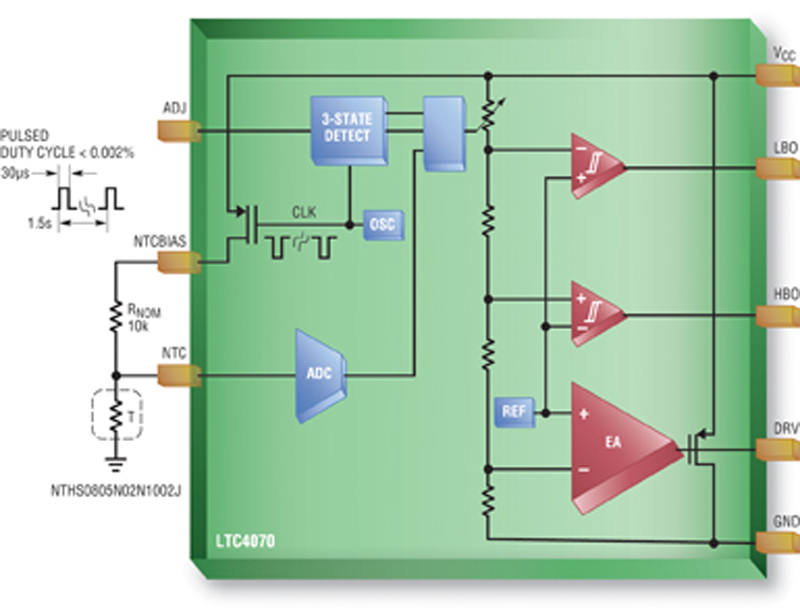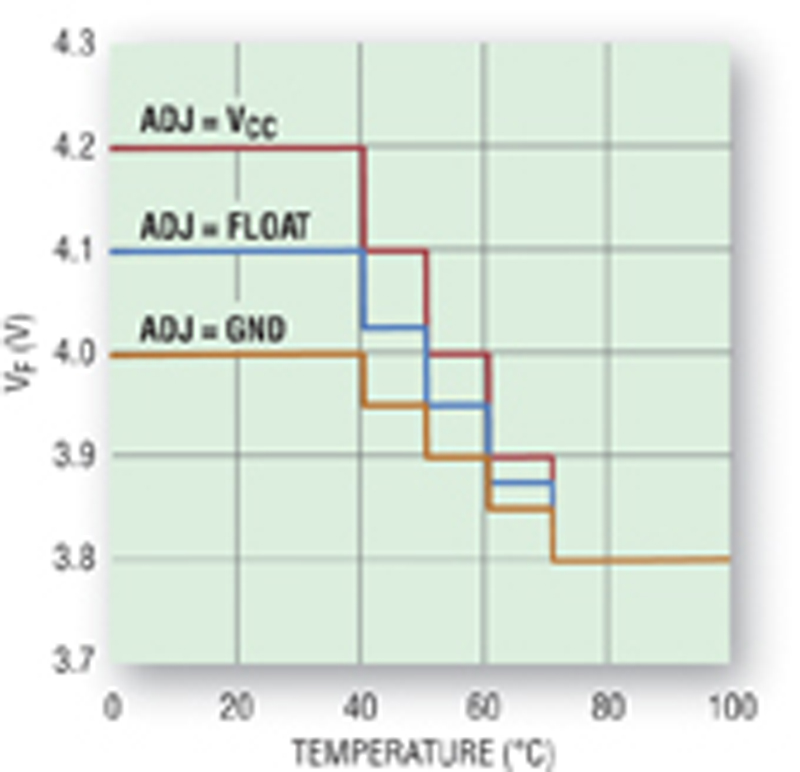Author:
Steve Knoth, Senior Product Marketing Engineer, Power Products Group, Linear Technology Corporation
Date
12/22/2010
Shunt voltage references are simple to use; they have been around for many years and are in a myriad of products. However, they cannot effectively charge a battery, and to configure one to do such a task can be extremely cumbersome. To-date, the ability to accurately and safely charge a Lithium-Ion/Polymer, coin cell or a thin film battery from a low-current source or an intermittent harvested energy type source has been unachievable. Embryonic in the market place, energy harvesting ICs can convert a transducer's signal into an input appropriate for a battery charger device. Recent technology developments have pushed energy harvesting to the point of commercial viability, even though it has been emerging since early 2000. In 2010, a "growth" phase is imminent for this technology. The opportunities in energy harvesting applications are widespread:

The LTC4070 provides a simple, reliable, and high performance battery protection and charging solution by preventing the battery voltage from exceeding a programmed level. Its shunt architecture requires just one resistor between the input supply and the battery to handle a wide range of battery applications. When the input supply is removed and the battery voltage is below the high battery output threshold, the LTC4070 consumes just 450nA from the battery. While the battery voltage is below the programmed float voltage, the charge rate is determined by the input voltage, the battery voltage, and the input resistor: ICHG = (VIN ? VBAT) / RIN As the battery voltage approaches the float voltage, the LTC4070 shunts current away from the battery thereby reducing the charge current. The LTC4070 can shunt up to 50mA with a float voltage accuracy of �1% over temperature. The shunt current limits the maximum charge current, but the 50mA internal capability can be increased by adding an external P-channel MOSFET; refer to Figure 1. Internally, the LTC4070 features a P-channel MOSFET being driven by amplifier EA (refer to Figure 2). Zero current will flow in that device until the voltage between VCC and GND reaches VF (i.e. the shunt voltage). VF can be modified by ADJ and NTC, but it is always between 3.8V and 4.2V. If the VCC voltage is below this level, then the current in the PFET is zero. If the voltage across VCC attempts to rise above VF, then current will flow in that device in an attempt to prevent the voltage from rising - this is the shunt current. The operating current is the current required to power all of the rest of the circuitry in the chip. If no external power supply is present, then this is the current that will be drawn from the battery. When the battery voltage is low, more voltage is placed across the input resistor, so the current into the battery (i.e. charge current) is slightly bigger than when the battery is fully charged. When the battery is fully charged, no current goes into the battery, and all of the input current goes into the shunt. Operating current is important because is sets a lower limit on the current capability of "practical" input sources. Obviously, an input source with just 100nA of drive capability would not be able to charge a battery with LTC4070. However, with 1uA of drive capability, there is a small amount of current left to charge. If 10uA of drive capability is available, then more than 90% of that current is available for charging.

NTC Battery conditioning circuit protects batteries The LTC4070 measures battery temperature with a negative temperature coefficient thermistor thermally coupled to the battery. NTC thermistors have temperature characteristics which are specified in resistance-temperature conversion tables. Internal NTC circuitry protects the battery from excessive heat by reducing the float voltage for each 10°C rise in temperature above 40°C (see Figure 3 for details) The LTC4070 uses a ratio of resistor values to measure battery temperature. The LTC4070 contains an internal fixed resistor voltage divider from NTCBIAS to GND with four tap points. The voltages at these tap points are periodically compared against the voltage at the NTC pin to measure battery temperature. To conserve power, the battery temperature is measured periodically by biasing the NTCBIAS pin to VCC about once every 1.5 seconds. Other key features The LTC4070 has a built-in 3-state decoder connected to the ADJ pin to provide three programmable float voltages: 4.0V, 4.1V, or 4.2V. The float voltage is programmed to 4.0V when ADJ is tied to GND, 4.1V when ADJ is floating, and 4.2V when ADJ is tied to VCC. The state of the ADJ pin is sampled about once every 1.5 seconds. When it is being sampled, the LTC4070 applies a relatively low impedance voltage at the ADJ pin. This technique prevents low level board leakage from corrupting the programmed float voltage. Eliminating resistors not only saves solution size but reduces quiescent current as high-valued resistors are not needed. The device also contains status outputs and signaling capability. The High Battery Monitor Output HBO is an active high CMOS output that indicates that the battery is fully charged and current is being shunted away from BAT. The Low Battery Monitor Output LBO is also an active high CMOS output that indicates when the battery is discharged below 3.2V. Finally, the external drive output pin, DRV, may be connected to the gate of an external PFET to increase shunt current for applications that require more than 50mA charge current (maximum 500mA). Conclusion Shunt references have many applications, and depending on their feature set, they can even be used to charge a battery. However, this type of implementation has many drawbacks including high quiescent current and lack of battery protection features. Low-power energy harvesting applications are now primed for conditioning by the right type of DC-DC converter or battery charger. Linear Technology developed the LTC4070 shunt charger system for Li-Ion/Polymer cells, coin cells and thin film batteries, to provide a simple, effective battery charging solution for cutting edge applications with low-power sources. www.linear.com